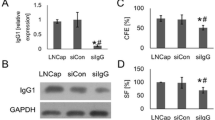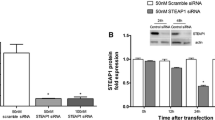Abstract
Toll-like receptors (TLRs) are widely expressed in immune cells and play a crucial role in many aspects of the immune response. Although some types of TLRs are also expressed in cancer cells, the effects and mechanisms of TLR signaling in cancer cells have not yet been fully elucidated. In the present study, we analyzed the effects of polyinosinic-polycytidylic acid [poly(I:C)], a TLR3 ligand, on three TLR3-expressing human prostate cancer cell lines (LNCaP, PC3, and DU145). We then further characterized the underlying mechanisms, focusing on the poly(I:C)-sensitive LNCaP cell line. Poly(I:C) significantly reduced the viability of LNCaP cells TLR3 and endosome dependently. One mechanism for the antitumor effect was caspase-dependent apoptosis, and another mechanism was poly(I:C)-induced growth arrest. Cell survival and proliferation of LNCaP cells depended on the PI3K/Akt pathway, and PI3K/Akt inhibitors induced apoptosis and growth arrest similar to poly(I:C) treatment. Additionally, poly(I:C) treatment caused dephosphorylation of Akt in LNCaP cells, but transduction of the constitutively active form of Akt rendered LNCaP cells resistant to poly(I:C). Immunoblot analysis of proliferation- and apoptosis-related molecules in poly(I:C)-treated LNCaP cells revealed participation of cyclinD1, c-Myc, p53, and NOXA. Interestingly, poly(I:C) treatment of LNCaP cells was accompanied by autophagy, which was cytoprotective toward poly(I:C)-induced apoptosis. Together, these findings indicate that TLR3 signaling triggers apoptosis and growth arrest of LNCaP cells partially through inactivation of the PI3K/Akt pathway and that treatment-associated autophagy plays a cytoprotective role.





Similar content being viewed by others
References
Takeda K, Kaisho T, Akira S (2003) Toll-like receptors. Ann Rev Immunol 21:335–376
Kelly MG, Alvero AB, Chen R et al (2006) TLR-4 signaling promotes tumor growth and paclitaxel chemoresistance in ovarian cancer. Cancer Res 66:3859–3868
Szczepanski MJ, Czystowska M, Szajnik M et al (2009) Triggering of toll-like receptor 4 expressed on human head and squamous cell carcinoma promotes tumor development and protects the tumor from immune attack. Cancer Res 69:3105–3113
He W, Liu Q, Wang L, Chen W, Li N, Cao X (2007) TLR4 signaling promotes immune escapes of human lung cancer cells by inducing immunosuppressive cytokines and apoptosis resistance. Mol Immunol 44:2850–2859
Salaun B, Lebecque S, Matikainen S, Rimoldi D, Romero P (2007) Toll-like receptor 3 expressed by melanoma cells as a target for therapy? Clin Cancer Res 13:4565–4574
Morikawa T, Sugiyama A, Kume H et al (2007) Identification of toll-like receptor 3 as a potential therapeutic target in clear renal cell carcinoma. Clin Cancer Res 13:7503–7509
Salaun B, Coste I, Rissoan MC, Lebecque SJ, Renno T (2006) TLR3 can direcetly rigger apoptosis in human cancer cells. J Immunol 176:4894–4901
Paone A, Starace D, Galli R et al (2008) Toll-like receptor 3 triggers apoptosis of human prostate cancer cells through a PKC-α-dependent mechanism. Carcinogenesis 29:1334–1342
Salaun B, Zitvogel L, Asselin-Paturel C et al (2011) TLR3 as a biomarker for the therapeutic efficacy of double-stranded RNA in breast cancer. Cancer Res 71:1607–1614
Matsumoto M, Seya T (2008) TLR3: interferon induction by double-strand RNA including poly(I:C). Adv Drug Deliv Rev 60:805–812
Chin AI, Miyahira AK, Covarrubias A et al (2010) Toll-like receptor 3-mediated suppression of TRAMP prostate cancer shows the critical role of type I interferons in tumor immune surveillance. Cancer Res 70:2595–2603
Vivanco I, Sawyers CL (2002) The phosphatidylinositol 3-Kinase AKT pathway in human cancer. Nat Rev Cancer 2:489–501
Paez J, Sellers WR (2003) PI3K/PTEN/AKT pathway. A critical mediator of oncogenic signaling. Cancer Treat Res 115:145–167
Davey RA, Hamson CA, Healey JJ, Cunningham JM (1997) In vitro binding of purified murine ecotropic retrovirus envelop surface protein to its receptor, MCAT-1. J Virol 71:8096–8102
Morita S, Kojima T, Kitamura T (2000) Plat-E: an efficient and stable system for transient packaging of retroviruses. Gene Ther 7:1063–1066
Kato H, Takeuchi O, Sato S et al (2006) Differential roles of MDA5 and RIG-I helicases in the recognition of RNA viruses. Nature 441:101–115
Rutz M, Metzger J, Gellert T et al (2004) Toll-like receptor 9 binds single-stranded CpG-DNA in a sequence- and pH-dependent. Eur J Immunol 34:2541–2550
Bertram J, Peacock JW, Tan C et al (2006) Inhibition of the phosphatidylinositol 3′-kinase pathway promotes autocrine Fas-induced death of phosphatase and tensin homologue-deficient prostate cancer cells. Cancer Res 66:4781–4788
Shukla S, MacLennan GT, Hartman DJ, Fu P, Resnick MI, Gupta S (2007) Activation of PI3K-Akt signaling pathway promotes prostate cancer cell invasion. Int J Cancer 121:1424–1432
Guan Z, Wang X, Zhu X et al (2007) Aurora-A, a negative prognostic marker, increases migration and decreases radiosensitivity in cancer cells. Cancer Res 67:10436–10444
Muise-Hemericks RC, Grimes H, Bellacosa A, Malstrom SE, Tsichlis PN, Rosen N (1998) Cyclin D expression is controlled post-transcriptionally via a phosphatidylinositol 3-kinase/Ae-depndent pathway. J Biol Chem 273:29864–29872
Graff JR, Konicek BW, McNulty AM et al (2000) Increased AKT activity contributes to prostate cancer progression by dramatically accelerating prostate tumor growth and diminishing p27Kip1 expression. J Biol Chem 275:24500–24505
Sharma M, Chuang WW, Sun Z (2002) Phosphatidylinositol 3-kinase/Akt stimulates androgen pathway through GSK3β inhibition and nuclear β-catenin accumulation. J Biol Chem 277:30935–30941
Ogawara Y, Kishishita S, Obata T et al (2002) Akt enhances Mdm2-mediated ubiquitination and degradation of p53. J Biol Chem 277:21843–21850
Thakkar H, Chen X, Tyan F et al (2001) Pro-survival function of Akt/protein kinase B in prostate cancer cells. Relationship with TRAIL resistance. J Biol Chem 276:38361–38369
Shankar S, Chen Q, Ganapathy S, Singh KP, Srivastava RK (2008) Diallyl trisulfide increases the effectiveness of TRAIL and inhibits prostate cancer growth in an orthotopic model: molecular mechanisms. Mol Cancer Ther 7:2328–2338
She QB, Ye SQ, O’Reilly KE, Lobo J, Rosen N (2005) The BAD protein intergrates survival signaling by EGFR/MAPK and PI3K/Akt kinase pathway in PTEN-deficient tumor cells. Cancer Cell 8:287–297
Levine B, Kroemer G (2008) Autophagy in the pathogenesis of diseases. Cell 132:27–42
Kabeya Y, Mizushima N, Ueno T et al (2000) LC3, a mammalian homologue of yeast Apg8p, is localized in autophagosome membranes after processing. EMBO J 19:5720–5728
Kim PK, Hailey DW, Mullen RT, Lippincott-Schwartz J (2008) Ubiquitin signals autophagic degradation of cytosolic proteins and peroxisomes. Proc Natl Acad Sci 105:20567–20574
González-Reyes S, Fernández JM, González LO et al (2011) Study of TLR3, TLR4, and TLR9 in prostate carcinomas and their association with biochemical recurrence. Cancer Immunol Immunother 60:217–226
Gall R, Starace D, Busa et al (2010) TLR stimulation of prostate tumor cells induces chemkine-mediated recruitment of specific immune cell types. J Immunol 184:6658–6669
Ilvesaro JM, Merrell MA, Swain TM et al (2007) Toll like receptor-9 agonists stimulate prostate cancer invasion in vitro. Prostate 67:774–781
Cully M, Shiu J, Piekorz RP, Muller WJ, Done SJ, Mak TW (2006) Transforming acidic coiled ciol 1 promotes transformation and mammary tumorigenesis. Cancer Res 65:10363–10370
Majumder PK, Sellers WR (2005) Akt-regulated pathways in prostate cancer. Oncogene 24:7465–7474
Malik SN, Brattain M, Ghosh PM et al (2002) Immunohistochemical demonstration of phosphor-Akt in high Gleason grade prostate cancer. Clin Can Res 8:1168–1171
Kreisberg JI, Malik SN, Prihoda TJ et al (2004) Phosphorylation of Akt (Ser473) is an excellent predictor of poor clinical out come in prostate cancer. Can Res 64:5232–5236
Ayala G, Thompson T, Yang G et al (2004) High levels of phosphorylated form of Akt-1 in prostate cancer and non-neoplastic prostate tissues are strong predictors of biochemical recurrence. Clin Cancer Res 10:6572–6578
Sarkar S, Peters KL, Elco CP, Sakamoto S, Pal S, Sen GC (2004) Novel roles of TLRs tyrosine phosphorylation and PI3 kinase in double-strand RNA signaling. Nat Struct Mol Biol 11:1060–1067
Tang DG, Li L, Chopra DP, Porter AT (1998) Extended survivability of prostate cancer cells in the absence of trophic factors: increased proliferation, evasion of apoptosis, and the role of apoptosis proteins. Cancer Res 58:3466–3479
Ghafar MA, Anastasiadis AG, Chen MW et al (2003) Acute hypoxia increases the aggressive characteristics and survival properties of prostate cancer cells. Prostate 54:58–67
Gewirtz DA (2009) Autophagy, senescence and tumor dormancy in cancer therapy. Autophagy 5:1232–1234
Hähnel P, Thaler S, Antunes E, Huber C, Theobald M, Schuler M (2008) Targeting AKT signaling sensitizes cancer to cellular immunotherapy. Cancer Res 68:3899–3906
Tormo D, Checinska A, Alonso-Curbelo D et al (2009) Targeted activation of innate immunity for therapeutic induction of autophagy and apoptosis in melanoma cells. Cancer Cell 16:103–114
Besch R, Poeck H, Hohenauer T et al (2009) Proapoptotic signaling induced by RIG-I and MDA-5 results in type I interferon-independent apoptosis in human melanoma cells. J Clin Invest 119:2399–2411
Acknowledgments
We thank Ms. Yasuko Moriyama for her technical assistance. We thank Dr. Davey RA for the mCAT-1 vector and Dr. Toshio Kitamura for the PLAT-E cells. This study was supported in part by a grant from the Ministry of Education, Culture, Sports, Science and Technology, Japan (no. 18591449 to M. H., no. 23701074 to N. H.), and Extramural Collaborative Research Grant of Cancer Research Institute, Kanazawa University.
Author information
Authors and Affiliations
Corresponding author
Electronic supplementary material
Below is the link to the electronic supplementary material.
Rights and permissions
About this article
Cite this article
Harashima, N., Inao, T., Imamura, R. et al. Roles of the PI3K/Akt pathway and autophagy in TLR3 signaling-induced apoptosis and growth arrest of human prostate cancer cells. Cancer Immunol Immunother 61, 667–676 (2012). https://doi.org/10.1007/s00262-011-1132-1
Received:
Accepted:
Published:
Issue Date:
DOI: https://doi.org/10.1007/s00262-011-1132-1




